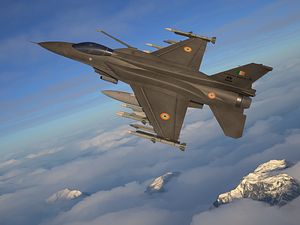U.S. defense contractor Lockheed Martin has offered India an upgraded version of the F-16 Fighting Falcon Viper (V) Block 70 multirole combat aircraft, designated F-21, as part of the the company’s bid to win a contract to supply the Indian Air Force (IAF) with 110 new fighter aircraft.
According to Lockheed Martin, the F-21 will be India’s pathway to the F-35 Lightning II fifth-generation fighter aircraft. “The F-21 has common components and learning from Lockheed Martin’s 5th Generation F-22 and F-35 and will share a common supply chain on a variety of components,” the company statement reads. “Approximately half of the F-21 and F-16 supply chains are common with the F-22 and F-35.”
The company did not offer any technical details or specifications regarding to the new fourth-generation F-21. Based on a company video, it appears that the upgraded fighter jet features a retractable refueling probe and a large-area display in the cockpit. “The F-21 is different, inside and out,” Vivek Lall, vice president of Strategy and Business Development for Lockheed Martin Aeronautics, said in a statement.
The core of the F-16V (F-21) upgrade consists of an Active Electronically Scanned Array (AESA) radar, a modern commercial off-the-shelf-based avionics subsystem, and a large-format, high-resolution display. The AESA radar system is Northrop Grumman’s AN/APG-83 Scalable Agile Beam Radar a variant of which is also installed on the F-35.
Lockheed Martin said that it would build the new aircraft in collaboration with India’s Tata Advanced Systems. The U.S. company announced last year that it will build all future wings for its F-16 fighters in India. Lockheed Martin and Tata Advanced Systems Limited concluded an agreement in June 2017 to underline the firms’ intent to establish a joint production facility for F-16 Block 70 fighter jets in India should the Indian Ministry of Defense (MoD) select the aircraft for the IAF.
The IAF is looking for over 100 new fighter aircraft. The service announced a request for information (RFI) to global vendors for the procurement of the aircraft in April 2018. The IAF is expected to complete its Air Staff Qualitative Requirements (ASQR), a list of capabilities and other parameters required from the new fighter, by next month after which a request for proposals (RFP) will be issued.
“The tender will be open for single-engine and twin-engine fighter jets. According to the RFI, the IAF is seeking to procure 82-83 (75 percent) single-seat fighter jets and 27-28 twin-seat variants (25 percent),” I explained. “Out of the 110 aircraft, 16-17 (15 percent) are to be bought in fly-away condition, whereas the rest are to be built in India under the framework of the [MoD]’s Defense Procurement Procedure 2016 to facilitate the manufacturing of military hardware locally.”
In addition to Lockheed Martin, Swedish aircraft maker Saab, French defense firm Dassault Aviation, the Eurofighter consortium, and Russia’s United Aircraft cooperation are participating in the tender. Boeing and Saab both announced that they would set up a production facility in India should their fighters — the F/A-18 Super Hornet and Gripen-E aircraft, respectively — be selected by the Indian MoD.

































